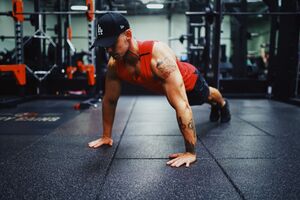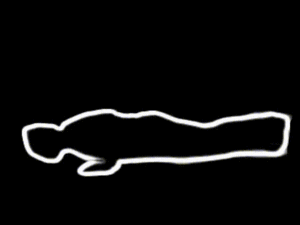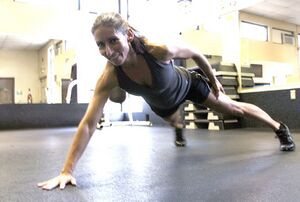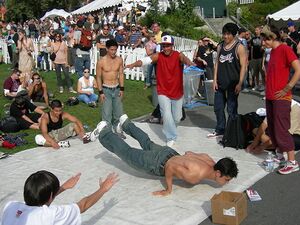Pushups
Introduction[edit | edit source]
The press-up or the push-up exercise is a very popular exercise used in upper extremity training. It is a closed kinetic chain exercise that requires no tools and uses the body weight for resistance[1]. It has many variations, so it can be adjusted according to the fitness level. They work the triceps, pectoral muscles, and shoulders. Using proper form, they can also strengthen the lower back and core by engaging (pulling in) the abdominal muscles. Push-ups are a fast and effective exercise for building strength.
Execution of conventional push-up[edit | edit source]
From a prone position, the hands are placed under the shoulders with the elbows extended. Keeping the back and legs straight with the toes touching the ground.
The body is lowered until the upper arm is parallel to the ground.
Then reverse the movement and raise the body until arm is extended.[2]
Muscles Involved[edit | edit source]
- The agonist (prime mover muscle): pectoralis major. As you lower yourself toward the floor, the pecs lengthen and control the speed of your descent. As you push back up again, they shorten. The lowering and lengthening phase of the exercise is called an eccentric contraction, while the lifting and shortening phase is called a concentric contraction.
- Antagonists (the muscle which opposes the agonist): the main ones are the middle fibres of the trapezius muscle, the posterior deltoids and the rhomboids (all on the opposite side of the torso in relation to your pecs).
- Synergists (helper muscles): Although not the target muscle of the exercise, these muscles are important as they assist the agonist. The main synergists in the push-up are the triceps and the anterior deltoids. They assist with elbow extension and shoulder flexion, respectively.
- Fixators: rotator cuff (keep the head of your humerus firmly located within the glenohumeral joint), the upper traps help with upward rotation of the scapulae, and core muscles (mainly the rectus abdominus and transversus abdominis[3], hold the spine straight). Other fixators include latissimus dorsi muscles (aid in shoulder stability) and quadriceps, which work to keep your legs straight and rigid[4].
Physiotherapy[edit | edit source]
Push-up exercise is a close chain kinetic exercise which improves the joint proprioception, joint stability and muscle co-activation around the shoulder joint.[5] Push-ups activate a large number of muscles together, increasing the demand on the heart muscle and the respiratory rate. Also, push-ups increase the metabolic rate so they can help with weight loss.[6] Push-up exercise could be used as a cheap and fast method for the assessment of individual’s functional capacity. A study by Justin Yang et al, concluded that participants who could perform more than 40 push-ups had lower risk of cardiovascular diseases than participants who could do less than 10 push-ups, this study was done on active adult men.[7]
One reason for their common use is due to the relative ease of learning the movement, no equipment is necessary for the movement and the exercise can be modified for greater or lesser difficulty depending on the level of physical fitness of the patient. This adaptability is represented by variations that can be used to modify the basic exercise in order to alter the difficulty of the conventional exercise that requires that the hands be placed in a natural position under the shoulder, the back straight, head up, and lower limb straight using the toes as the pivotal point.
If the patient lacks upper body strength, they may find it frustrating that they are unable to perform push-ups with good form. In such cases, it is recommended that the patient follow a program of exercise progression with push-up variations, as exemplified in this video:
For those seeking to treat patients with shoulder dysfunctions or pathologies, it is recommended to perform push-up plus exercises rather than focusing solely on building strength. As opposed to a typical push up where one is supported on both hands and toes on the floor, and lowers their body to the ground before returning, the push up plus is done with the arms extended from the same starting position as a push up. However, instead of lowering to the floor, the participant protracts their scapula.
Variations[edit | edit source]
There are many variations of the push-up exercise, each targeting different muscles groups, including:
- Knee push-ups (great for beginners).
- Wall push-ups
- Incline push-ups with torso elevated is good for beginners; this is a slightly tougher push-up variant compared to knee and wall push-ups. Incline push-ups are performed with the hands positioned higher than the feet. This could be progressed by bringing the body closer to the ground.
- Decline push-ups with feet elevated: require you to keep your legs on a higher plane and hands on the floor. You can use a bench, a box, or any piece of furniture to do this push-up. This uses a greater percentage of the body weight so it is used for more advanced levels in training.[8]
- Narrow palmer width increased muscles activity of the pectoralis major and minor, triceps brachii and infraspinatus while wide palmer width increased the muscles activity of the serratus anterior which is an important in scapular stability.[9]
- The backward and forward push-ups should be performed with caution as they increase the activity of the back and abdominal muscles, increasing the intervertebral joint compressive forces.[10]
- Push-up exercise on an unstable surface increased the activation of the serratus anteiror muscle but not all unstable devices increase the muscle activity compared to conventional push-up. The use of suspension device increased the muscle activity of serratus anterior, lumbrar multifidus and rectus femoris compared to other unstable devices.[11]
- One-arm push-up: fantastic challenge to face. Once you have built your core and upper body strength and endurance by practicing the above 9 types of push-ups, you may try the one-arm push-up. It works on the core, shoulders, chest, biceps, triceps, and forearm muscles[12].
- Push-ups plus or serratus anterior push up: Start at the tip of a push-up position and move the scapula only into protraction/retraction[13]. It can correct the scapular kinematics as it produces high muscular activity of the serratus anterior and low muscular activity of the upper trapezius, on the other hand scapular protraction decreases the subacromial space which can increase the risk for impingement of the rotator cuff tendons.[14] The serratus muscle activity increases in the push up plus exercise as the leg angle increases (by raising the foot platform).[15]
Research on muscle activation[edit | edit source]
Recently, adding an unstable surface while performing the push-up has been suggested in order to increase muscular activity. But research shows that the addition of unstable surfaces in push-up training does not provide greater improvement in muscular strength and endurance than push up training performed on a stable surface in young men[16].
Other research suggests that, if a goal is to induce greater muscle activation during exercise, then push-ups should be performed with hands in a narrow base position compared with a wide base position[17].
On the other hand, a study that looked at the force generated by six different types of push-ups performed by 23 fit people found that push-ups with the feet elevated produced the most force, while push-ups with the hands elevated or done from the knees produced less force. Gender and height didn't seem to affect the force produced by the different push-up variations[18].
According to a 2020 study[19] on shoulder electromyography activity during push-up variations, the triceps and pectoralis major muscles had the highest electromyography amplitude during unstable push-ups, suspension push-ups, incline push-ups with hands on a ball, and standard push-ups. The study also found that the serratus anterior muscle had the highest electromyography amplitude during push-up plus and incline push-ups. The greatest global electromyography amplitude was observed during unstable surface push-ups.
References[edit | edit source]
- ↑ Healthline Benefits of pushups Available:https://www.healthline.com/health/fitness-exercise/pushups-everyday (accessed 16.12.2021)
- ↑ Chulvi‐Medrano I, Martínez‐Ballester E, Masiá‐Tortosa L. COMPARISON OF THE EFFECTS OF AN EIGHT‐WEEK PUSH‐UP PROGRAM USING STABLE VERSUS UNSTABLE SURFACES. International journal of sports physical therapy. 2012 Dec;7(6):586.
- ↑ Azeem K. The Push-Up. International Journal of Fitness, Health, Physical Education & Iron Games,(2). 2015 Jan;1.
- ↑ AZ central Anatomy pushup Available:https://healthyliving.azcentral.com/anatomy-push-up-15456.html (accessed 16.12.2021)
- ↑ Uhl TL, Carver TJ, Mattacola CG, Mair SD, Nitz AJ. Shoulder musculature activation during upper extremity weight-bearing exercise. Journal of Orthopaedic & Sports Physical Therapy. 2003 Mar;33(3):109-17.
- ↑ Azeem K. The Push-Up. International Journal of Fitness, Health, Physical Education & Iron Games,(2). 2015 Jan;1.
- ↑ Yang J, Christophi CA, Farioli A, Baur DM, Moffatt S, Zollinger TW, Kales SN. Association between push-up exercise capacity and future cardiovascular events among active adult men. JAMA network open. 2019 Feb 1;2(2):e188341-.
- ↑ Contreras B, Schoenfeld B, Mike J, Tiryaki-Sonmez G, Cronin J, Vaino E. The biomechanics of the push-up: Implications for resistance training programs. Strength & Conditioning Journal. 2012 Oct 1;34(5):41-6.
- ↑ Kim YS, Kim DY, Ha MS. Effect of the push-up exercise at different palmar width on muscle activities. Journal of physical therapy science. 2016;28(2):446-9.
- ↑ Marcolin G, Petrone N, Moro T, Battaglia G, Bianco A, Paoli A. Selective activation of shoulder, trunk, and arm muscles: a comparative analysis of different push-up variants. Journal of athletic training. 2015 Nov;50(11):1126-32.
- ↑ Borreani S, Calatayud J, Colado JC, Moya-Nájera D, Triplett NT, Martin F. Muscle activation during push-ups performed under stable and unstable conditions. Journal of Exercise Science & Fitness. 2015 Dec 1;13(2):94-8.
- ↑ Stylecraze Pushups Available: https://www.stylecraze.com/articles/pushups-for-women-and-their-benefits/(accessed 16.12.2021)
- ↑ Therapeutic associates The push up plus Available:https://www.therapeuticassociates.com/the-push-up-plus-your-exercise-for-naturally-amazing-posture/ (accessed 9.1.2022)
- ↑ Lunden JB, Braman JP, LaPrade RF, Ludewig PM. Shoulder kinematics during the wall push-up plus exercise. Journal of shoulder and elbow surgery. 2010 Mar 1;19(2):216-23.
- ↑ Lee S, Kim J. The effect of leg angle during push-up plus exercise on shoulder stabilization muscle activity. Journal of physical therapy science. 2019;31(1):33-5.
- ↑ Chulvi‐Medrano I, Martínez‐Ballester E, Masiá‐Tortosa L. Comparison of the Effects of an Eight‐Week Push‐Up Program Using Stable Versus Unstable Surfaces. International journal of sports physical therapy. 2012 Dec;7(6):586.Available: https://www.ncbi.nlm.nih.gov/pmc/articles/PMC3537455/ (accessed 16.11.2021)
- ↑ Cogley RM, Archambault TA, Fibeger JF, Koverman MM. Comparison of muscle activation using various hand positions during the push-up exercise. Journal of strength and conditioning research. 2005 Aug 1;19(3):628. Available:https://pubmed.ncbi.nlm.nih.gov/16095413/ (accessed 16.12.2021)
- ↑ Ebben, W. P., Wurm, B., VanderZanden, T. L., Spadavecchia, M. L., Durocher, J. J., Bickham, C. T., & Petushek, E. J. (2011). Kinetic analysis of several variations of push-ups. The Journal of Strength & Conditioning Research, 25(10), 2891-2894. Available at https://www.cochranelibrary.com/central/doi/10.1002/central/CN-00806213/full?highlightAbstract=ups%7Cup%7Cshoulder%7Cpush
- ↑ Kowalski, K. L., Connelly, D. M., Jakobi, J. M., & Sadi, J. (2022). Shoulder electromyography activity during push-up variations: a scoping review. Shoulder & Elbow, 14(3), 325-339. Available at https://www.ncbi.nlm.nih.gov/pmc/articles/PMC9121296/pdf/10.1177_17585732211019373.pdf










